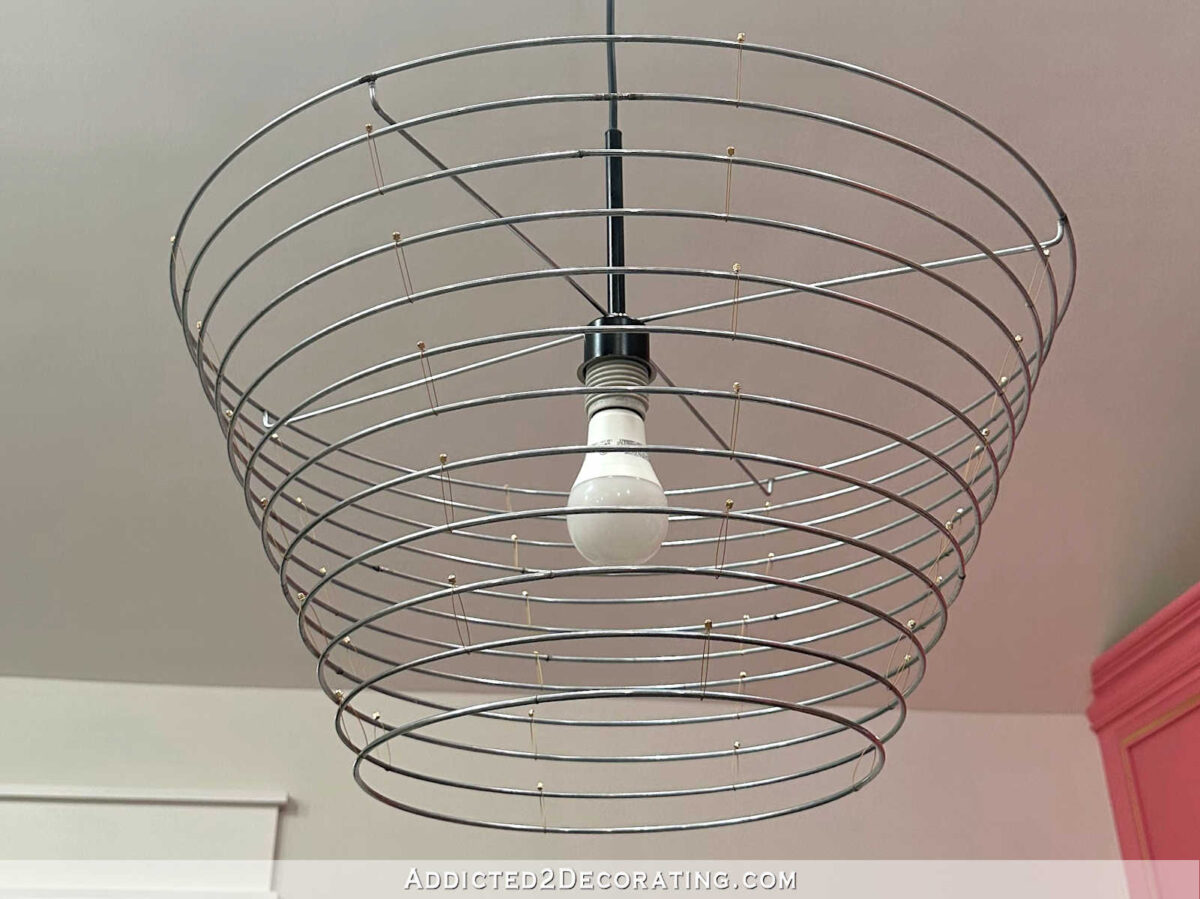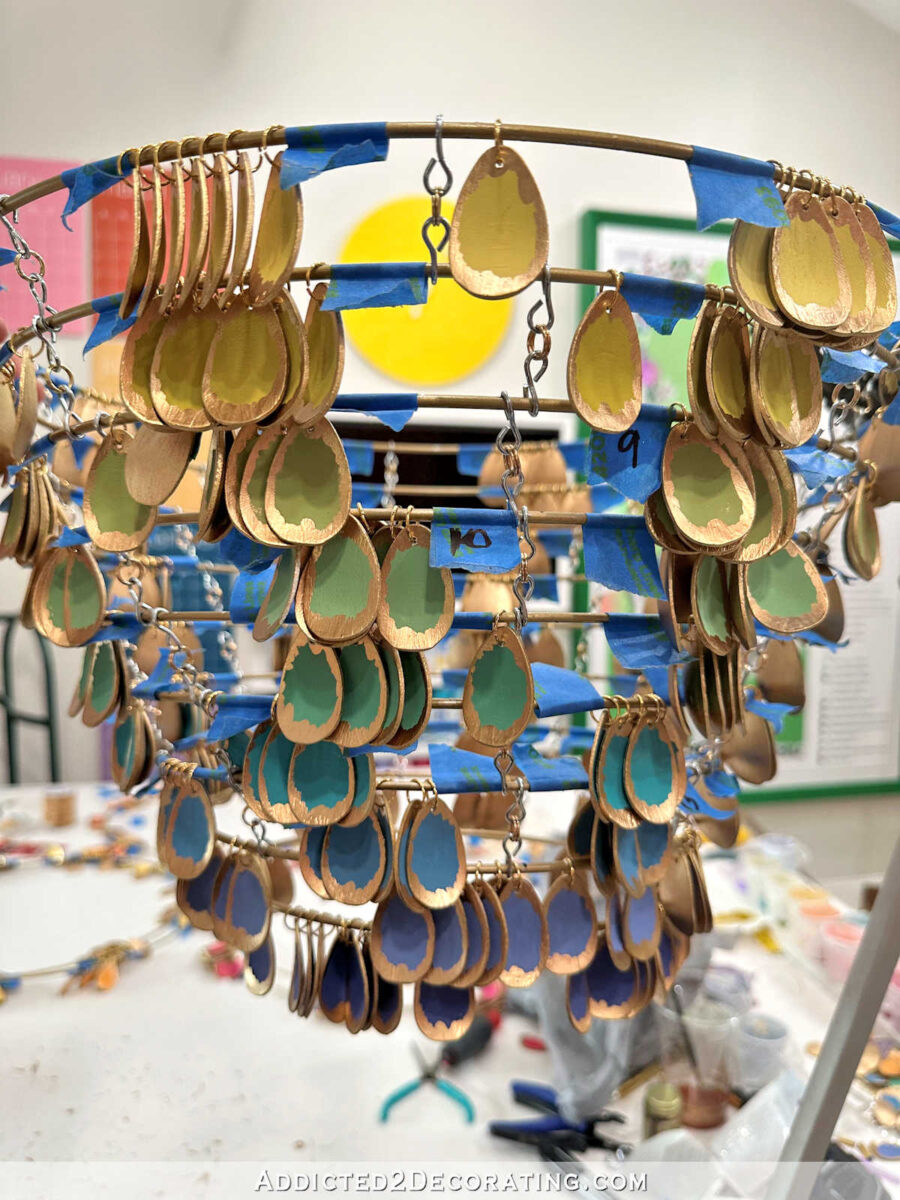[ad_1]
One thing I love about DIY is trial and error. The thing I hate most about DIY is trial and error. 😀 I know, I can be confusing. I prefer trial and error as long as the trials and errors are only two or three rounds. Trial and error is a great way to learn about new processes and products. But if that trial and error phase goes more than two or three rounds, before I see the process and/or product achieving my goal, I start to get really frustrated. And that’s exactly what happened this past weekend.
On Friday, I’m sure I can have all the spoons painted and assembled on the lampshade rings for the pendant light above my studio desk. But I also said I wasn’t confident I could muster all the light over the weekend. I thought that was the complicated part. And if I’m right, I honestly don’t know how right I am. I had no idea what I was trying to do, and I had no idea that it would take me ten tries and ten different ideas (and nine failures) before I found the right solution. Here’s how my weekend went…
Idea #1
My first idea was to reassemble the light using the first idea I had when I assembled the lampshade rings a few weeks ago. That first time, I used beading wire and screw-on crimp beads, both of which are used for jewelry making.


So I started using that process to reassemble all the rings after I attached the painted spoons to the rings. But the more rings I assembled, the less confident I was that the top wire and crimp beads would hold the weight of all the rings with the weight of the added spoons. When I abandoned that idea and decided to find something sturdy to hold the lampshade rings together, I assembled about five rings, starting at the top and working my way down.
Idea #2
Since I attached all the spoons to the lampshade rings using jump rings and I had a lot left over, I had the idea of using a small piece of jewelry chain and jump rings to attach the rings to each other.


That sounds like a great idea, I’ll add some chains/rings, then one chain will slip off the jump ring and the whole thing will curve. I put it back on only to have another chain slip off another jump ring and the whole thing goes crooked again. The problem was obviously that the chain was too thin and I couldn’t close the jump rings to stop the chain slipping through the break in the jump ring. So I needed a new idea.
Idea #3
I needed something simple, and my mind immediately went to S-hooks. How easy could that be?! I couldn’t imagine anything being easier or faster! Or so I thought. I went to Home Depot and bought enough of these 1.25-inch S-hooks to assemble the whole thing. I had high hopes.


I mean, look how easy! Slide the S-hook over the two lampshade rings, use pliers to crimp the hooks so that they are clamped around the lampshade ring wire, and taa-daa, complete! right? It’s quick and simple!


Except it’s very small. This caused each row of spoons to pretty much cover the spoons in the next row, so that only half (or maybe less) of the spoons in the next row.


And I assembled about five lampshade rings, second-guessing my decision the entire time, before deciding they were too small. So I had to disassemble all those rings. And those S-hooks aren’t easy to remove once they’re folded over the lampshade rings!
Idea #4
I needed to come up with a way to extend the S-hook a bit, so I tried extending it with a jump ring. And I was able to use a jump ring on the top and bottom to extend it further.


But before I got too far with it, I decided to abandon the idea of jump rings altogether. They’re great for jewelry, and they’re great for holding an individual (and very lightweight) spoon to a lampshade ring. But they are not made to hold much weight. And I don’t trust them enough to trust the assembly of an entire pendant light from tiny jump rings made for jewelry making.
Idea #5
So I moved on to my next idea – little S-hooks. I thought these were easier to work with and easier to crimp onto the lampshade rings than the larger 1.25-inch S-hooks.


So I put two of them together and…


…not only was it ugly, but it was very small. However, I should have known that. If a 1.25-inch S-hook is too short, two 3/4-inch S-hooks are too short, since they are literally the same length.
Idea #6
Then I tried using a 1.25-inch S-hook and a .75-inch S-hook. The length is fine. I would say it was perfect. But those S-hooks crimped together and then folded over the lampshade rings weren’t easy, and they didn’t look good. It looked big and bulky and I wanted something smaller that didn’t look so big.


Ideas #7 and #8
So I went back to Home Depot and this time I bought the smallest chain they had with links that could be pulled apart (ie, I couldn’t use a chain with closed links). This is what they have.


I had high hopes. But the problem is that if I use all three links, it’s too long…


And if I use two links, it’s too short.


Both links lead me to the same length as a large S-hook.


I literally need 2.5 links. That would be the right length, but I don’t want to cut those links in half. Although it is possible to cut them in half because of how they are made and use only 1/2 link, cutting it in half would look ugly. I didn’t want to do that. So I went back to the drawing board.
Idea #9
I went back to take one last look at any options at Michael’s and I bought these split rings. Split rings are like key chain rings, but they are for jewelry, so they are much smaller.


I basically had the idea that I could create my own chain from split rings. And since jump rings are not used and split rings are more secure, I’m sure it will work. So I bought everything they had and went home. But I quickly realized that this idea was a bust. I’ve been trying to put two split rings together (and ruining my fingernails in the process), but the split rings are so tight that I’ve never put the two together, much less made a chain. So there was no way I was going to sit there and try to assemble enough to put the whole light together. I don’t think there’s any way I could get one of those split rings around the lampshade ring wire.
Idea #10 — It Worked!
Then it came to me. Split rings are 1/2 the size of a link of a smaller chain. And 2.5 links of that chain are the perfect length. So I took two individual links of the chain and assembled them with a split ring in the middle and this is what I have…


And…it worked!!! Alas, if you heard the muffled sound of someone crying tears of joy and relief around 5:30pm yesterday, it was me. It took me ten tries, but I finally…Finally… found something that works. It’s strong, so there’s no way it’s going to break on me. And it’s the perfect length. It’s not the perfect color, but it’s nothing a little paintbrush and some liquid gold gilding can’t fix.


So I got nine rings together before bed last night, and instead of attaching each ring to the next ring in four places, I decided to do eight. This makes the whole thing more stable. I haven’t lined them up yet because I’m still assembling everything. But once I get it all assembled, I go back and line everything up properly, and then start placing the spoons.


When it comes to DIY, I usually have a stick-to-activity. But let me tell you, ten rounds of trial and error was almost enough to break me. If I hadn’t spent all those hours cutting, sanding, priming, painting, gilding and attaching the spoons to the lampshade rings, I would have left five rounds and thrown them in the trash. But after all the work I had already done, I was determined to see it through. But the next project that takes me ten rounds of trial and error probably won’t be so lucky.

Addicted 2 Decorating shares my DIY and decorating journey as I renovate and decorate the 1948 Fixer Upper that my husband, Matt, and I purchased in 2013. Matt has MS and is unable to do physical activity, so I do most of the housework myself. You can learn more about me here.